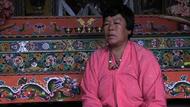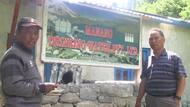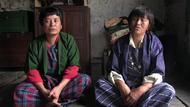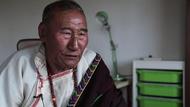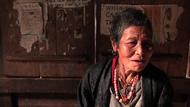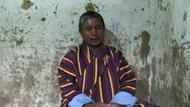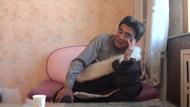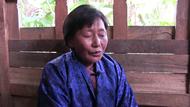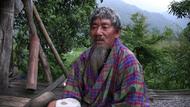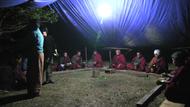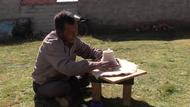Video Overview
A resident monk provides a brief description of the buildings and features of Pabongka just north of Lhasa.
- Lhasa
- Ü
- Pabongkha
- India
- ཕ་བོང་ཁ་འདི་བོད་ཀྱི་དགོན་པ་གཞན་མ་ཆགས་གོང་ལ་དང་པོ་ཆགས་ཡོད་པ་གསུངས་ཡོད།It is said that the Pabongka was first Buddhist monastery built in Tibet.
- ཕ་བོང་ཁ་འདི་སྔོན་ཐོག་བརྩེགས་དགུ་ཐོག་བྱས། འདི་བཞེངས་ཚར་བའི་རྗེས་ལ་འདི་ས་ལྷག་རྡོ་ལྷག་དེ་ཚོས་གཙུག་ལག་ཁང་དང་པོ་ཏ་ལ་བཞེངས་པ་རེད་གསུངས་བ་རེད།Originally, the building was nine-stories tall. After its construction, its remaining construction materials, like sand and stones, were said to be used to build the Jokhang Temple and Potala Palace in Lhasa.
- རྒྱལ་པོ་གླང་དར་མའི་སྐབས་བསྟན་པ་བསྣུབས་བྱས་ཐོག་བརྩེགས་དགུ་མར་ཐོག་ཤིགས། བསྟན་པ་བསྣུབས། ཆོས་མེད་པ་བཟོས་པ་རེད།During the reign of King Langdarma, a nine-story structure was destroyed along with the Buddha dharma.
- ཡང་བསྟན་པ་དར་བྱས་ད་ལྟ་ཐོག་བརྩེགས་གསུམ་ཐོག་རེད། ཕ་བོང་ཁ་ཆགས་ས་འདི་རུས་སྦལ་མོ་དང་། སྟོད་དུ་རུས་སྦལ་ཞིག་ཡོད་པ་དེ་རུས་སྦལ་ཕོ་རེད།During the later spread of the Buddhist doctrine, the current three-story structure was rebuilt.
- རྟེན་གཙོ་བོ་སྤྱན་རས་གཟིགས་རང་བྱུང། དཀྱིལ་འཁོར་སྒང་གི་སྐུ་ཕུང་འདི་གས་ལ་འཕོ་བ་མ་ཐེབས་པ་ཡིན་ན་རང་བཞིན་གྱིས་འཕོ་བ་སྐྱོན་གྱི་ཡོད་གསུངས་ཡོད།The main attraction of Pabongka is the naturally occurring Avalokiteśvara. It is believed that those deceased people who failed to receive phowa receive it by the power of Avalokiteśvara at the site.
- ཕ་བོང་ཁའི་གནས་འདི་ནི་བདེ་མཆོག་གི་གནས་རེད། མདུན་དུ་དུང་དཀར་རང་བྱུང་དང་གདུགས་རང་བྱུང་། བདེ་མཆོག་གཞན་པ། གསེར་ཕུག་སྒྲོལ་མ་ཉི་ཤུ་རྩ་གཅིགThe place is adobe of Cakrasaṃvara, an important tantric deity. In front of it naturally is occurring conch and parasol. Then we have another Cakrasaṃvara and the Twenty-one Taras.
- ཕ་བོང་ཁ་ལ་བསྟན་པ་རྒྱས་ན་བོད་ཡོངས་ལ་བསྟན་པ་དར་གྱི་ཡོད་གསུངས་ཡོད། བོད་ཡོངས་དེ་གོང་ནས་གོང་འཕེལ་འགྲོ་ཡགIt is believed that if Buddhism flourishes here, it will also flourish in the rest of Tibet.
- ལྷ་ཁང་འདི་ད་ལོ་བཞེངས་པ་རེད། འདི་ནང་དུ་རིགས་གསུམ་མགོན་པོ་རང་བྱོན་དང་། རྟེན་གཙོ་བོ་འཇམ་དཔལ་དབྱངས། ཕྱག་ན་རྡོ་རྗེ་དེ་གས་ཡོད།This shrine was recently rebuilt which now house the naturally occurring Three Lord of the Families, namely, Avalokiteśvara, Manjuśri, and Vajrapani.
- དེ་ནས་མ་ནི་གི་གུ་ཞིག་ཡོག་རེད། ཐོན་མི་སམ་བྷོ་ཊས་རྒྱ་གར་ནས་ཚུར་བོད་དུ་ཕེབས་རྗེས་མ་ཎི་ཕ་བོང་ཁར་བརྩམས།After Thonmi Sambhota returned from India, he created the first six syllabled mantra in Tibetan here.
- བོད་ལ་ཐོག་མར་ཡི་གེ་མེད་གསུངས་ཡོད། ཁོང་གིས་འདིར་ཚུར་ཕེབས་བྱས་ཡིག་ཕུད་དེ་ཕ་བོང་ཁར་ཕུལ། གཉིས་པ་དེ་གཙུག་ལག་ཁང་དུ་ཡོད།Before the invention of Tibetan script by Thonmi, it is said there is no written Tibetan script. After its creation, he made the first offering of the letter he invented to Pabongka and the second one to Tsuklhakhang Temple in Lhasa.
- ཕར་ཕྱོགས་ཀྱི་ཤིང་དེ་བྱང་ཆུབ་ཀྱི་ཤིང་རེད། ཕ་གི་དུར་ཁྲོད་རེད། དགོན་པ་དང་ཁ་སྤྲོད་རེད། སྤྱན་རས་གཟིགས་རང་བྱོན་གྱིས་འཕོ་བ་ཁ་ཐུག་སྐུ་ཕུང་སྐྱོན་ལ་སྐྱོན་གྱི་ཡོད།That one is a Bodhi tree. The one on the opposite site of Pabongka is a charnel ground.
- སྐུ་ཕུང་གང་འདྲ་ཞིག་སླེབས་ཀྱང་འཕོ་བ་རང་བཞིན་གྱིས་སྐྱོན་གྱི་ཡོད་ཟེར། འཕོ་བ་མ་ཐེབས་པ་ཡིན་ན་སྤྱན་རས་གཟིགས་ཀྱིས་རང་བཞིན་གྱིས་གདན་དྲངས་ཀྱི་ཡོད་ཟེར།Body of any deceased person brought here is believed to receive phowa automatically by the blessing of Avalokiteśvara.
- བྱས་ཙང་ཕ་བོང་ཁར་ཡོང་བྱས་གསོལ་བ་སྨོན་ལམ་འདེབས་ནས་བྲེལ་ལ་མ་བྱས་ན་འགྲུབ་ཡག་ཡོད།So anyone who comes here and prays sincerely, their wishes get fulfilled.
- འདི་གཤམ་དུ་ཡོད་པ་དེ་མཆིན་པ་རང་བྱོན་ཕ་བོང་རེད། དེའི་ཚུར་ཕྱོགས་དེ་གློ་བ་རང་བྱོན་ཕ་བོང་རེད།Below one is naturally occurring liver-shaped rock, and that is the lung-shaped rock.
- ཕ་བོང་གི་སྟོད་དུ་སྲོང་བཙན་སྒམ་པོའི་སྒྲུབ་ཕུག་ཡོད། ཐོག་མར་ཕྱག་བཏབ་མཁན་ཆོས་རྒྱལ་སྲོང་བཙན་སྒམ་པོ་ཁོང་རེད།Pabonga was built by King Songtsen Gampo and his meditation cave is located just above it.
- སྟོད་དུ་རྗེ་ཙོང་ཁ་པའི་སྒྲུབ་ཕུག་ཞིག་ཡོད། དེ་ཆོས་རྒྱལ་སྲོང་བཙན་སྒམ་པོ་སྒྲུབ་ཕུག་སྟོད་ཀྱི་ལྷ་ཁང་གཞིགས་དོའི་ནང་དུ་ཡོད།Then there is Tsongkhapa’s meditation cave, which is located in the remnants of the destroyed old shrine close to king's meditation cave.
- སྟོད་ཀྱི་ལྷ་ཁང་སེར་པོ་དེར་རྗེ་གཟིགས་པ་ལྔ་ལྡན་ཡོད། དེའི་འོག་ལ་མཆོད་རྟེན་བརྒྱ་དང་བརྒྱད་ཡོད།In the yellow temple above, it enshrines the five sights of Tsongkhapa. Below that structure, there are 108 stupas.
- དེ་མ་ཎི་ལྷ་ཁང་རེད། དེ་བཞེངས་ནས་ལོ་བརྒྱད་དགུ་ཙམ་འགྲོ་ཡོད།That is one is Mani Shrine which was reconstructed about eight to nine years back.
- རྟེན་གཙོ་བོ་རིག་གསུམ་མགོན་པོ་ད་ལོ་གསར་པ་བཞེངས་པ་རེད།It contains the newly commissioned statues of Three Lord of Families.
- ཕ་བོང་ཁ་བསྟན་པ་རྒྱས་ན་བོད་ཡོངས་ལ་བསྟན་པ་རྒྱས་ཀྱི་ཡོད། ཕ་བོང་བཞེངས་ཚར་རྗེས་དེའི་ས་ལྷག་རྡོ་ལྷག་གིས་གཙུག་ལག་ཁང་དང་པོ་ཏ་ལ་བཞེངས། སེ་འབྲས་ལ་སོགས་བཞེངས།As said earlier, if Buddhism flourishes here, it will thrive in the rest of Tibet.
- བོད་ཀྱི་དགོན་པའི་རྟེན་གཙོ་བོ་ཕ་བོང་ཁ་ཆགས་ཡོད།After its construction, Pabongka became the chief Buddhist monastic relic among all Tibetan monasteries.
 Loading ...
Loading ... 